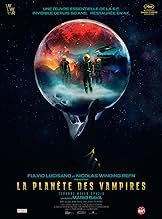CALIFICACIÓN DE IMDb
6.2/10
7.4 k
TU CALIFICACIÓN
Tras aterrizar en un planeta misterioso, un equipo de astronautas empiezan a enfrentarse unos a otros, influidos por el planeta y sus extraños habitantes.Tras aterrizar en un planeta misterioso, un equipo de astronautas empiezan a enfrentarse unos a otros, influidos por el planeta y sus extraños habitantes.Tras aterrizar en un planeta misterioso, un equipo de astronautas empiezan a enfrentarse unos a otros, influidos por el planeta y sus extraños habitantes.
- Premios
- 1 nominación
Ángel Aranda
- Wess Wescant
- (as Angel Aranda)
Federico Boido
- Keir
- (as Rico Boido)
Vito Fasano
- Dead Galliott Crew Member
- (sin créditos)
Giuseppe Mattei
- Brent
- (sin créditos)
Argumento
¿Sabías que…?
- TriviaThis film marks the first collaboration between Mario Bava and his son/assistant director Lamberto Bava. Lamberto would later become a director himself.
- ErroresWhen Toby and Mark duke it out, Toby bumps into and moves the flight seat revealing it to be unattached to the deck.
- Citas
Capt. Mark Markary: I'll tell you this, if there 'are' any intelligent creatures on this planet... they're our enemies.
- Versiones alternativasThe original Italian version runs 88 minutes long. The US version runs 86 minutes long.
- ConexionesFeatured in Aweful Movies with Deadly Earnest: The Demon Planet (1969)
Opinión destacada
I saw this film in it's 1965 American release, and at the time I was not overly impressed. It was obviously made on a low budget, the dialog dubbing is bad (although far superior to some other Italian imports I have seen), the acting alternates between wooden (Barry Sullivan) and outrageously overdone (i.e., "gravity effects", the reaction of the actor who smashes the "meteor deflector", numerous fear reaction shots of crew members). Time has proven that it has become a trend setter for numerous subsequent sci-fi films (most notably Ridley Scott's "Alien" (1979)). I recently viewed it again 37 years after it's release, and the similarities to "Alien" are unmistakable. The attentions of the crews of both films are attracted by mysterious radio signals originating from an unexplored world. The horseshoe shape of the ships in POTV resembles that of the wrecked alien spacecraft in "Alien". There are similar shots of the ship's landing gear in both films. Both crews find ancient wrecked spacecraft and skeletal remains of giant aliens on the planets they land upon. There is an unknown predatory alien presence in both films. Lots of gore footage exists in both films too, although POTV unarguably started this trend (alas, is there any recent sci-fi film that does not fall to this temptation?).I cannot believe that all these similarities are coincidental, and I suspect that Dan O'Bannon must have been heavily influenced by POTV, whether he realized it or not.
The use of lighting and color are also noteworthy. POTV still looks good today due to colorful exterior scenes (forgive the somewhat clumsy use of composite shots of the crew in a few scenes set against an obviously miniature landscape). Please also forgive the overzealous use of the zoom lens, which had just been developed at the time. One big demerit in set design comes from a scene inside the wrecked alien spacecraft. A prominently-featured prop appears to be the taillight lens from a 1957 Packard, complete with the backup light lens below it. It is positioned vertically in the shot, and perhaps the set designer was hoping that Italian audiences would not recognize it. Another detractor is the almost unlimited amount of area inside the ships. No ceilings are visible, and the various compartments look as big as football fields when compared to realistic spacecraft design criteria.
I found this to be an entertaining if somewhat flawed film, certainly more enjoyable than it was when I first watched it in 1965. It deserves a vote of 6/10.
The use of lighting and color are also noteworthy. POTV still looks good today due to colorful exterior scenes (forgive the somewhat clumsy use of composite shots of the crew in a few scenes set against an obviously miniature landscape). Please also forgive the overzealous use of the zoom lens, which had just been developed at the time. One big demerit in set design comes from a scene inside the wrecked alien spacecraft. A prominently-featured prop appears to be the taillight lens from a 1957 Packard, complete with the backup light lens below it. It is positioned vertically in the shot, and perhaps the set designer was hoping that Italian audiences would not recognize it. Another detractor is the almost unlimited amount of area inside the ships. No ceilings are visible, and the various compartments look as big as football fields when compared to realistic spacecraft design criteria.
I found this to be an entertaining if somewhat flawed film, certainly more enjoyable than it was when I first watched it in 1965. It deserves a vote of 6/10.
- biker45
- 6 abr 2002
- Enlace permanente
Selecciones populares
Inicia sesión para calificar y agrega a la lista de videos para obtener recomendaciones personalizadas
Detalles
- Fecha de lanzamiento
- Países de origen
- Idiomas
- También se conoce como
- Planet of the Vampires
- Locaciones de filmación
- Productoras
- Ver más créditos de la compañía en IMDbPro
Taquilla
- Presupuesto
- USD 200,000 (estimado)
- Tiempo de ejecución1 hora 28 minutos
- Mezcla de sonido
- Relación de aspecto
- 1.66 : 1
Contribuir a esta página
Sugiere una edición o agrega el contenido que falta

Principales brechas de datos
What is the Brazilian Portuguese language plot outline for El planeta de los vampiros (1965)?
Responda



























